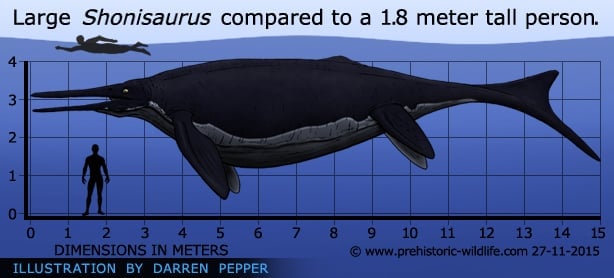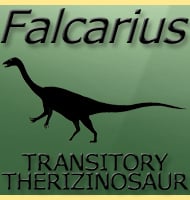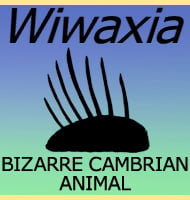In Depth
Body features, swimming and feeding behaviour
Shonisaurus is a firm favourite amongst researchers of marine reptiles, not just because of its large size but because it is known from so many remains, best known from the Berlin-Ichthyosaur State Park in Nevada, USA. These represent individuals of all ages and also reveal a rather surprising age related development regarding the teeth. In very small juveniles teeth are present at the forward portions of the jaws, while older and larger individuals do not have teeth at all. This is not a case of the teeth falling out, but growing out and the presence of teeth as a juvenile characteristic suggests that they were only there to give young Shonisaurus a head start in life.
While Shonisaurus was a large and in certain aspects, specialised ichthyosaur it also appears to be quite primitive. Study of the tail reveals that it most likely had a tail fluke similar to a fish although in a slightly different orientation. The main muscular area that allowed for controlled movement of the tails dipped downwards into what is termed the lower lobe of the caudal (tail) fin, whereas fish like sharks however have bodies that curve upwards into the fin. Usually the part of the caudal fin that the body curves into is the most developed and so reconstructions of living Shonisaurus often show the lower portion of the tail to be larger and more developed than the upper portion. This can also suggest that Shonisaurus may have been a comparatively slow swimmer as fast swimming animals usually have tails where the upper and lower portions are roughly equal in both size and proportion.
Another area of possible inaccuracy in some depictions of Shonisaurus is the dorsal fin, in that it seems that Shonisaurus didn’t have one. No dorsal fin bone has ever been recovered in association with Shonisaurus remains, and other similar ichthyosaurs are also known to be lacking dorsal fin fossils as well, but later and more advanced ichthyosaurs are known to have had them. Current thinking explains this as either a complete lack of dorsal fins in living Shonisaurus, or that the fins were composed of a softer material like cartilage, similar to how they are in sharks. As ichthyosaurs developed over successive generations the cartilage could have ossified to form a permanent bony structure seen in more advanced forms. Without a fossil imprint however this remains speculation.
The lack of teeth in the jaws suggests that Shonisaurus had a preference for soft bodied animals such as cephalopods like squid. This is actually in quite strong contrast to other large deep water ichthyosaurs such as Temnodontosaurus which have deep rooted teeth for cracking the shells of animals like ammonites. Like in other large ichthyosaurs the large size of Shonisaurus meant that it could take in more air at the surface and stay down deeper for longer, increasing hunting time. Squid would have also been an abundant food supply for Shonisaurus to exploit as they breed in large numbers and quickly attain adult size ensuring that they quickly replaced their numbers.
Key features of Shonisaurus are its four limbs which interestingly for a fusiform marine creature are all the same size, although similar sized front and rear limbs are seen in other basal ichthyosaurs. Usually the front limbs are much larger and serve to counter the downwards effect of swimming by the tail. Other sea creatures (especially fast swimming ones) suffer from a downwards pitching effect caused by propelling themselves from the rear with their tails, and without their front fins they would nosedive into the ocean abyss whenever they swam. This is also why on a side note the size of the front fins can be taken as a guide to the animals behaviour, as the faster the animals could swim, the larger the front fins need to be to counter the downward pitch.
All four limbs being the same size however may have meant that Shonisaurus had greater vertical plane control, basically meaning it could pitch to swim up or down much more quickly. This is a considerable advantage when you consider that cephalopods like squid usually swim up and down between different depths rather than side to side. As such feeding behaviour for Shonisaurus could see it cruising around until it located a pocket of squid and then swimming up and down to follow them.
Shonisaurus was once regarded as the largest known ichthyosaur, but the largest fossil specimen once attributed to Shonisaurus has actually been found to be that of another previously named genus called Shastasaurus. As such Shastasaurus is now considered the largest known ichthyosaur, and is also a contender for the largest known marine reptile.Shonisaurus and the Kraken - Problems and explanation
In late 2011 Shonisaurus made headlines around the world, but not because of the fact that it was a magnificent ichthyosaur, but because a large number of them had been killed and eaten by a giant cephalopod such as an octopus or squid, or at least this was the hypothesis proposed by Mark McMenamin and Dianna Schulte McMenamin in a lecture to a meeting of the Geological Society of America. The basis of this theory comes from the observation that one assemblage of Shonisaurus remains bears a striking visual similarity to an octopus. The explanation for this similarity was that an unknown prehistoric cephalopod had arranged the Shonisaurus bone into a form of self-portrait.
Fellow geologists and palaeontologists were for the most part unimpressed by this proposition. Cephalopods are one of the most intelligent life forms on this planet, and octopuses in particular do exhibit problem solving skills. Aside from the classic example of an octopus unscrewing and opening a jaw to get food within, any keeper of octopuses will tell you that they are extraordinary escape artists, and if not secured properly they can escape their own tanks and even enter other nearby aquariums. Despite this level of intelligence however, cephalopods have never been observed to create self-portraits. In fact an octopus shown its reflection in a mirror may even exhibit aggression towards its own mirror image.
The other obvious problem about this theory is that there is no body or other form of physical evidence to suggest the presence of a giant cephalopod. Immediately some people would say that there is no body because cephalopods have only soft tissue and this does not fossilise. Back in the early days of palaeontology this would have been accepted fact, but today we know better. Fossils of the early fish, specifically the shark Cladoselache have been found to include the presence of mineralised soft tissue which has revealed everything from muscle fibres to some internal organs. These remains also date back to the Devonian period, making them much older than the Triassic age remains of Shonisaurus. On top of this a handful of fossilised impressions of octopus bodies are actually known to science. At the very least soft tissue preservation for a cephalopod is possible if the conditions were correct, although the lack of soft tissue preservation on the Shonisaurus may suggest that this is not the case in this instance. One part of the octopus that should almost certainly preserve however is its beak. Made from keratin the beak is the hardest part of the body and is developed for biting through the shells of armoured prey like crustaceans. Tentacle hooks might also be preserved, but the presence of these is dependent upon the specific genus, not the cephalopod group.
So without physical evidence of a body, and a proposal for behaviour so far not observed in living cephalopods, we are left with a set of Shonisaurus remains that resemble a picture of a cephalopod. The answer is very simple; you just have to think of a loaf of sliced bread. When the loaf is taken out of the packet the ends fall off to one side with the slices in-between falling on top of one another in an overlapping arrangement. Now you don’t actually need a loaf of bread to see this, you can test it with books stood on end and allowed to fall over, the resulting observation is still the same.
While we only know Shonisaurus from bones we must remember it was a living animal first, and when it died its body would have sunk to the bottom and rested upon its side as is usually seen when animals like fish and whales die. In this arrangement the ribs and vertebrae would have actually been in an upright vertical arrangement within because the body was keeping them in place together. As the body decayed and was presumably eaten by scavengers however this support would have been lost, resulting in the ribs and vertebrae falling and overlapping one another as the resulting fossils are. From here the bones were probably quickly covered in sediment as exposed bones do not survive for long in sea water. As the bones fossilised they may have been subject to an even greater amount of distortion that pushed the ribs into a more focused area giving the appearance of tentacles. Evidence for this comes from the ribs being broken in similar places suggesting that they were all subject to the same forces. Over two-hundred million years later and with only a part of the original animal surviving and you have a conclusion that the remains are most probably a case of simulacrum, and only appear to be a giant cephalopod to human eyes, much in the same way clouds can sometimes be interpreted as looking like other things.
Unfortunately many news sources picked up upon the announcement of this theory but did not bother to pick apart the details so that all they presented to the wider public wasn’t much more than just a headline to grab people attention. While others have since tried to talk about the theory in its proper context of fossil interpretation and possible extent of animal, specifically cephalopod, intelligence, the story still appeared as ‘proof’ of the existence of giant cephalopods. It is probably only a matter of time before it is used as the basis for a straight to home release B movie.
However the real significance about the Berlin-Ichthyosaur State Park bone bed is actually the mystery as to why so many Shonisaurus of all different ages have ended up being so close to one another, and if they all died together as a group. If the group theory is correct then it brings the suggestion that ichthyosaurs may not have just looked like dolphins, but lived in social groups like them as well. Alternatively and just as likely is that the assemblage of Shonisaurus individuals was caused by environmental circumstances.
First and perhaps the simplest is that the area had an abundant supply of squid, possibly Shonisaurus’s preferred prey, and that a greater number of Shonisaurus converged upon the same area. This could easily explain the presence of older individuals that may have died from old age but it does not explain the presence of juveniles unless disease and possible predation is a factor. Another theory is they all became beached and died soon after not being able to return to the sea, something that is quite easy to imagine as mass beaching has been seen in whales. Poisoning is also another viable theory which sees the Shonisaurus exposed to a prehistoric red tide. Red tides are essentially mass algal blooms that can result in large scale releases of toxins that poison all kinds of marine life, in this case not just affecting Shonisaurus but also the animals that it preyed upon as well. These are but a small number of theories that could explain the presence of the Shonisaurus together, with some including underwater ocean currents causing the bodies to drift into submerged catch areas that would have been sheltered to further disruption from currents. The truth of the matter is just as likely to either be none or even a combination of the above factors, but new fossil discoveries of Shonisaurus and other related marine reptiles may one day reveal a greater insight into this mystery.
Further Reading
– A revision of the skeletal reconstruction of Shonisaurus popularis (Reptilia: Ichthyosauria). – Journal of Vertebrate Paleontology 10 (4): 512–514. – Bradley F. Kosch – 1990. – Taphonomy and Paleoecology of Shonisaurus popularis (Reptilia: Ichthyosauria). – PALAIOS 7 (1): 108–117. – J. A. Hogler – 1992. – A reinterpretation of the Upper Triassic ichthyosaur Shonisaurus. – Journal of Vertebrate Paleontology 19: 42–49. – Chris McGowan & Ryosuke Motani – 1999. – Triassic kraken: the Berlin Ichthyosaur death assemblage interpreted as a giant cephalopod midden. – Geological Society of America Abstracts with Programs 43 (5): 310. – M. A. S. McMenamin & D. L. Schulte-McMenamin – 2011.










